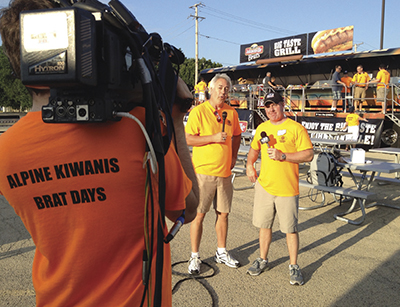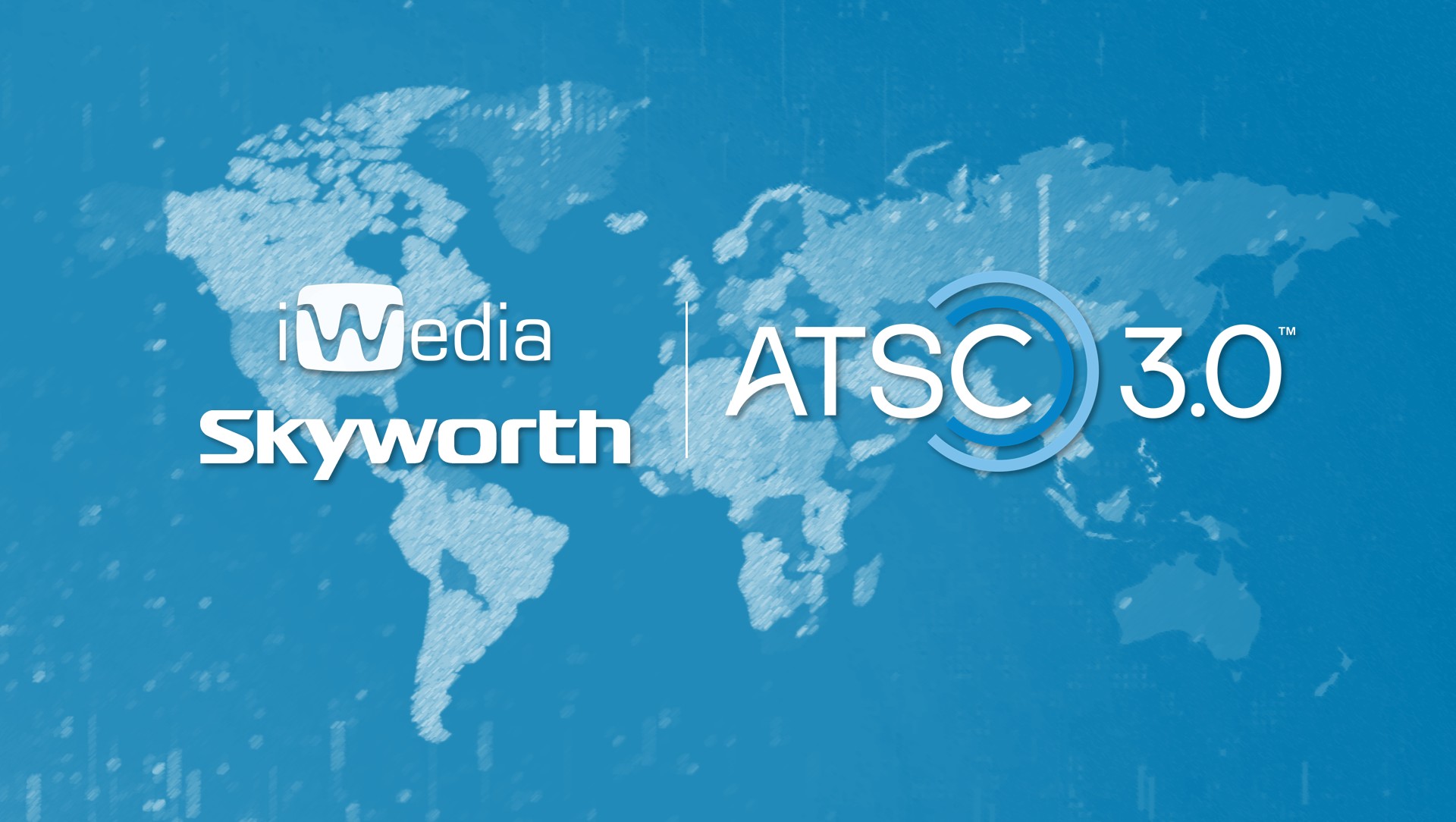Bonded-Cellular Boosts ENG

Last month, Frontline Communications demonstrated a next-generation CNG/ENG Ka IP D-SNG vehicle they built for Philadelphia ABC affiliate WPVI-TV at Frontline’s headquarters in Clearwater, Fla. Representatives attending the demo included (L to R): Dean Jordan, Viasat; Steve Williamson, Frontline; John Evans, AVL; Jim Casabella, ABC; Jerry Ford, WPVI; Neal Metersky, Dejero, and Jonathan Sherr, Frontline.
HAMILTON, N.J.—When it comes to sending a live shot back to the station, there are no more excuses. Armed with portable, low-cost systems like camera back radios and backpacks—that transmit IP video over bonded (4G/3G LTE) cellular, Ka-band satellite, microwave, or Wi- Fi—camera ops can shoot live video from almost anywhere.
The only hitch is there has to be sufficient bandwidth. If nearby cell towers are maxed out or blocked, bonded cellular devices may not have sufficient bandwidth to send live video. Systems that combine bonded cellular plus IP/ satellite, microwave, and other signal paths automatically search for the most efficient transmission option, even while the camera op is shooting, then back haul the live signal.
REVOLUTIONARY TREND
So if camera operators can run right to the edge of a breaking news story and start transmitting live video, do we still need ENG/SNG trucks? Industry experts say yes—bonded cellular and ENG trucks are complementary—for the foreseeable future.
“Bonded cellular is absolutely an important trend and you probably won’t find a station these days that doesn’t have some type of bonded cell technology,” said Rob Gibson, manager of engineering and digital media for WRC-TV NBC4 in Washington, D.C. “But it’s not a replacement for our traditional microwave or SNG trucks. It’s essentially an extra tool in our toolbox that helps our camera operators in the field get that live shot.”
As a news leader in the eighth largest U.S. TV market, WRC fills about 7.5 hours of live news daily, plus morning and evening shows on the weekends. “Bonded cellular lets you go live in situations where you otherwise can’t use a live truck,” Gibson said.
A good example of this occurred last month when the Lincoln Memorial was defaced by vandalism. The National Park Service would not allow an ENG truck or wired cameras into the area, but they did permit a WRC cameraman with bonded cellular to walk right up the steps and shoot live video to show the green paint streaks at the base of Lincoln’s statue.
The professional video industry's #1 source for news, trends and product and tech information. Sign up below.
“This capability gives us an advantage we didn’t have years ago and it’s extremely important for producing a high-quality newscast and staying competitive in our market,” Gibson said. WRC puts a variety of bonded cellular systems on its trucks, including multiple units of Dejero and LiveU systems.
Despite the increasing use of cellular bonded ENG systems, business, at least for one ENG vehicle manufacturer, is brisk.
“We’re building over 300 news vehicles per year, which is unprecedented, and our highest production level in 20 years,” said Thomas P. Jennings, president of Accelerated Media Technology in Auburn, Mass. AMT can convert new or existing vehicles as small as a Subaru Forrester SUV or conventional platforms like the all-new GM Savanna Diesel 3500 van, among other models, for bonded cellular or KA-band satellite.
“There’s no economic case to justify building half-million dollar SNG trucks anymore,” Jennings added. “These smaller vehicles, which can cost less than $100,000 each, use less expensive hardware, require less skilled operators, and lower the cost of doing business. When stations put more ENG vehicles on the road covering stories, it can double or triple their reach in the market, help with capital costs, and possibly yield higher ratings and increased viewership.”
VIDEO-RICH NEWSCASTS
Jeff Clark, operations manager at 23NEWS WIFR, the CBS affiliate serving Rockford, Ill., said their two TVUPack cellular backpacks enable them to fill their 4.5 hours of daily news with field interviews and reports, including live shots that couldn’t be obtained by their two ENG trucks.

(L to R): Camera Operator Alex Nowak uses a TVUPack cellular backpack to cover Andy Gannon and Aaron Wilson, anchors of WIFR’s “23NEWS This Morning,” as they report live from 2013 Brat Days in Rockford Ill. “On election day in November 2012, we had to station our two ENG trucks outside the Democratic and Republican headquarters in Rockford,” Clark said. “Having the two TVUPacks meant we could still cover other stories live, such as interviewing Congressional candidates who were not at the headquarters, making our newscasts more visually dynamic and informative.”
In mid-July, the station broadcast live from a local event where bratwurst hotdogs were being sold to benefit the Alpine Kiwanis Club. WIFR parked its ENG truck and had Andy Gannon and Aaron Wilson— anchors of 23NEWS This Morning—show viewers the big grill and thousands of cars pulling through to pick up their bratwurst.
“Andy and Aaron decided to show viewers what it was like to ride through the line, so they got in a car and started driving around the parking lot while the cameraman in the backseat transmitted that live video back to the station,” Clark said. “We could never have televised from inside our microwave truck while it was moving.”
Last month, ENG truck company Frontline Communications demonstrated a next generation CNG/ENG/ SNG vehicle they built for Philadelphia ABC affiliate WPVI at their headquarters in Clearwater, Fla. The demo showed how the Dejero encoder on a Ford E350 HT cargo van automatically selects the optimal transmission path and switches between high-speed, two-way IP video over Ka-band satellite and bonded cellular.
Live 1080p HD video was sent from the vehicle in Florida to WPVI-TV where it was received in exceptional HD quality. Frontline equipped the Ka-band SNG vehicle with an AvL 1.2m antenna, AvL controller, and ViaSat Tria feed and modem, and a Dejero LIVE+ VSET (bonded cellular) wireless transmitter.
“The most exciting things about this new technology are the flexibility of the transmission path, and the cost, considering the Ka-band DSNG system costs about half that of the traditional Ku-band DSNG system when using a customer-provided bonded cellular encoder,” said Steve Williamson, director of sales for Frontline Communications. “This, combined with Viasat’s high-capacity satellite architecture makes the combination of bonded cellular, microwave, and Ka-band satellite technology very compelling. We expect that demand will be very strong for combining these technologies in new trucks and existing fleets.”
MULTIMODE OPERATION
This fall, Vislink will ship NewStream, a mobile broadcast microwave transmission system that combines both licensed and unlicensed RF technologies within a single, friendly user interface. In a 2RU space, NewStream combines ENG, SNG, and CNG. NewStream is part of Vislink’s new Live Gear product line, which also includes Air Cam Max, which lets the camera operator transmit via the 2 GHz or 7 GHz frequency or via bonded cellular.
Prior to the 2013 NAB Show, Eric McCulley, product marketing manager for broadcast for the Billerica, Mass.-based company, canvassed broadcast engineering customers to ask if any were planning to get rid of their fixed ENG/SNG assets in favor of cellular. The consensus was that they planned to keep their ENG/SNG backbone but supplement it with cellular.
“That’s why we decided to come out with multimode transmission at NAB, and we see strong demand for it,” McCulley said, “By combining SNG and CNG with 2 GHZ/7 GHz microwave—a system broadcasters own and control—they can increase the dependability of getting a high-quality live signal back to the station.” Live Gear includes camera back radios, transmission systems with automatic OLED smart switches, as well as rooftop and mast mounted antennas.
Having been instrumental in the BAS relocation program, McCulley raised an interesting point, warning that “the ENG spectrum is still under pressure, and by touting the virtues of cellular, broadcasters might be unwittingly inviting the FCC to consider taking more spectrum from them.”
CONNECT LIVE
Next month, Integrated Microwave Technologies and Dejero will ship a new combined product, Dejero + Nucomm Connect Live. Manufactured by IMT, Connect Live is a camera-mounted bonded cellular and COFDM microwave system for ENG, powered by Dejero’s LIVE+ Core software. Through Dejero’s intelligent Connection Management, the Connect Live transmitter automatically manages dataflow across each connection.
“Through this partnership, Dejero adds a compact, camera-back bonded cellular system with COFDM microwave capability to its product line,” said John B. Payne IV, vice president of engineering and CTO for IMT in Mount Olive, N.J. “Stations benefit because Dejero packages minutes from multiple cellular carriers and streamlines the management of bonded cellular billing and data cards by serving as a single point of contact.”
VARIETY OF OPTIONS
Devens, Mass.-based Comrex offers LiveShot, a portable and rackmount live low-latency video over IP system for CNG and ENG. LiveShot mounts between the camera and battery pack and supports live HD/SD video transmission via (3G/4G LTE) bonded cellular, Ethernet or Wi-Fi. Reporters can use cellular or Wi-Fi to send live IP video back to the station over the public Internet or over a private Wi-Fi network to their vehicles where they can transmit it via Ka-band satellite or microwave, provided they have transmission equipment installed for those signal paths.
“The bandwidth requirements to send live 1080i HD video are relatively high, so broadcasters need a variety of transmission options to get the signal back reliably to their studios,” said Chris Crump, director of sales and marketing.
“Since cellular towers can become overloaded if many reporters are trying to send live video from a news location, the addition of Wi-Fi helps give broadcasters some wireless autonomy to get signals to their nearby vehicles, where they can be relayed to the studio,” said Crump. “For customers who depend on ENG trucks in the field, we’re offering a compatible, wireless IP video transmission technology that’s essentially another tool in the toolbox for live news backhaul.”

